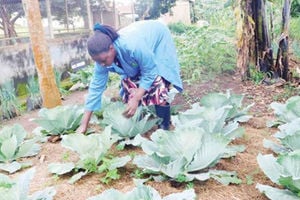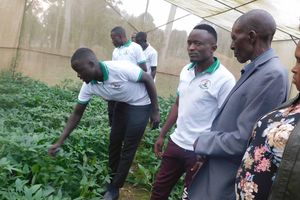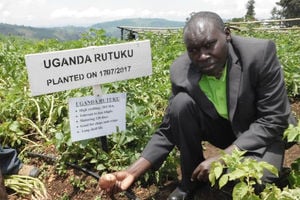
Dr Abel Arinaitwe, a plant pathologist, shows a diseased potato. He encouraged farmers to opt for clean seed. PHOTO/GEORGE KATONGOLE
Organic Irish potatoes contain a higher content of nutritionally important minerals with higher amounts of vitamin C, iron, magnesium, and phosphorus.
These Irish potatoes are best when baked, fried, or used in casseroles. They are organically grown without harmful pesticides, herbicides and fertilisers.
Organic potato production normally fits into a planned rotation on an organic farm. It is possible for a specialist potato farmer to develop organic potatoes on an organic farm.
It may be possible to have a single field in organic crop production, providing it operates a suitable planned rotation.
Organic potatoes can be adequately isolated from any other potatoes developed on the farm. Potatoes are also a great source of vitamin B6, copper, potassium, antioxidants and dietary fibre.
Soil requirement
The soil should be friable, porous and well drained. The optimum pH range for potato farming is 4.8 to 5.4. It is a very cool weather crop. Potato is mostly developed as a rainfed crop. It is cultivated in regions getting a rainfall of 1200 – 2000 mm per annum.
Organic soil preparation
Healthy soil is a source of organic farming. Organic matter in the form of cover crops, compost, or manure creates a soil that is biologically active, with good structure and capacity to hold nutrients & water.
Potato plants require fertiliser, however too much can cause leggy, disease-prone growth. Add generous amounts of compost, or during planting dig in a little amount of natural fertiliser or organic poultry manure. Most gardeners find that the second application of fertiliser, a month or so after planting, helps develop yields.
Planting date
The ideal planting date varies widely, depending on region and altitude. The most important factor to find out the planting date is soil temperature. It must be around 8°C or 6°C for pre-sprouted potatoes. The soil must be sufficiently dry.
Planting depth
The tops of seed potatoes must be level with the original soil surface. New potatoes should be earthed up less than ware potatoes to get quick emergence.
Plant the potatoes
A few days before planting, cut seed potatoes into one or two eyes (buds) on them. Avoid problems by allowing the cut pieces to dry indoors for a day or two, and dust with agricultural sulfur to help keep against fungal diseases.
Plant the seed pieces about a foot apart and two or three inches deep in rows, hills, or raised beds or containers (particularly where diseases have been found before).
Prevent sunscald, bitter flavor and tuber greening (indicates a high amount of a poisonous plant alkaloid called solanine). As plants develop, lightly pile soil or thick straw over their lower stems; repeat as needed until six or eight inches of the lower are buried.
Phases of growth
Potato growth is separated into five phases. During the first phase, sprouts emerge from the seed potatoes and root growth begins.
During the second, photosynthesis begins as the plant develops leaves and branches. In the third stage, stolons develop from the lower leaf axils on the stem and grow downwards into the ground.
This phase is often, but not always, connected with flowering. Tuber bulking occurs through the fourth phase when the plant begins investing the majority of its resources in its newly formed tubers.
Soil nutrient management
To produce a healthy crop, sufficient soluble nutrients should be available from the soil to meet the minimum requirements for the whole plant.
The total nutrient needs of a crop are much higher than the nutrients that are removed from the field when that crop is harvested. All of the roots, stems, leaves and other plant parts require nutrients at specific times during plant growth and development.
Restrictions in the supply of required plant nutrients will limit growth and reduce crop quality and yields. The challenge in organic systems is balancing soil fertility to supply these necessary plant nutrients at a time.




